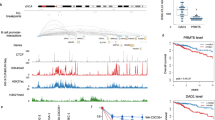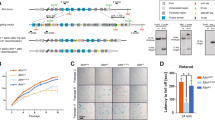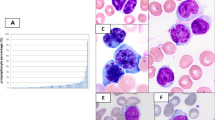Abstract
Chronic lymphocytic leukaemia (CLL) results from the accumulation of apoptosis-resistant clonal B cells that are arrested in G0/G1, and is heterogeneous with respect to clinical outcome. An aggressive form of the disease is identified by an impaired p53 response to ionizing radiation (IR). This is associated with inactivating mutations of either p53 or ATM, a regulator of p53 activated by IR-induced DNA damage. Since other forms of DNA damage activate p53 via ATR, a kinase closely related to ATM, abnormalities of the ATR-p53 pathway also have the potential to result in p53 dysfunction. We therefore tested cases of CLL for abnormal p53 responses to ultraviolet irradiation (UVC), a known activator of ATR, to screen for additional forms of p53 dysfunction. CLL cells and normal peripheral blood mononuclear cell (PBMC) preparations (predominantly noncycling lymphocytes) were treated with UVC and assessed for p53 responses. In all of the CLL cases and PBMC preparations tested, we were unable to detect p53 accumulation, phosphorylation or transcriptional consequences in response to UVC-induced DNA damage. The most likely explanation for the absence of UVC-induced p53 activation in CLL and normal lymphocytes was that, in contrast to other cell types, the UVC-induced ATR pathway was inactive. This notion was confirmed by showing that ATR protein was absent or undetectable in all of the cases of CLL and normal PBMCs screened. This was an unexpected finding because ATR was thought to be essential for the viability of somatic cells and for normal human and murine embryonic development. An obvious difference between the cell lines used as positive controls for ATR antibodies and the CLL cells/PBMCs was that the former were actively cycling while the latter were quiescent. We therefore hypothesized that the ATR-p53 pathway is selectively downregulated in noncycling lymphocytes. To test this, we induced cycling in the T-cell fraction of PBMC preparations and demonstrated that ATR protein expression was restored. Furthermore, p53 was upregulated and phosphorylated in response to UVC in these cells. Our data support the conclusion that the ATR-p53 pathway is suppressed in noncycling lymphocytes via ATR downregulation. We tentatively suggest that this repressed DNA damage response may have evolved to protect quiescent lymphocytes from the potential for p53-dependent apoptosis in the face of some forms of endurable genotoxic stress. If this is the case, DNA repair and genome stability might be compromised in quiescent lymphocytes with potentially negative consequences.
This is a preview of subscription content, access via your institution
Access options
Subscribe to this journal
Receive 50 print issues and online access
$259.00 per year
only $5.18 per issue
Buy this article
- Purchase on Springer Link
- Instant access to full article PDF
Prices may be subject to local taxes which are calculated during checkout





Similar content being viewed by others
References
Abou-Zhar F, Bejjani B, Kruyt FAE, Kurg R, Bacino C, Shapira SK and Youssoufian H . (1999). Am. J. Med. Genet., 83, 388–391.
Abraham RT . (2001). Genes Dev., 15, 2177–2196.
Bakkenist CJ and Kastan MB . (2003). Nature, 421, 499–506.
Banin S, Moyal L, Shieh S, Taya Y, Anderson CW, Chessa L, Smorodinsky NI, Prives C, Reiss Y, Shiloh Y and Ziv Y . (1998). Science, 281, 1674–1677.
Bean LJH and Stark GR . (2001). Oncogene, 20, 1076–1084.
Bernstein C, Bernstein H, Payne CM and Garewal H . (2002). Mutat. Res., 511, 145–178.
Blagosklonny MV . (2002). Int. J. Cancer, 98, 161–166.
Bogdanov KV, Chukhlovin AB, Zaritskey AY, Frolova OI and Afanasiev BV . (1997). Br. J. Haemat., 98, 869–872.
Brown EJ and Baltimore D . (2000). Genes Dev., 14, 397–402.
Brown EJ and Baltimore D . (2003). Genes Dev., 17, 615–628.
Brown JM and Wouters BG . (1999). Cancer Res., 59, 1391–1399.
Butler MG, Hall BD, Maclean RN and Lozzio CB . (1987). Am. J. Med. Genet., 27, 645–649.
Caligaris-Cappio F and Hamblin TJ . (1999). J. Clin. Oncol., 17, 399–408.
Canman CE, Lim DS, Cimprich KA, Taya Y, Tamai K, Sakaguchi K, Appella E, Kastan MB and Siliciano JD . (1998). Science, 281, 1677–1679.
Chanan-Khan A, Holkova B, Perle MA, Reich E, Wu CD, Inghirami G and Takeshita K . (2003). Haematologica, 88, ECR14.
Cliby WA, Roberts CJ, Cimprich KA, Stringer CM, Lamb JR, Schreiber SL and Friend SH . (1998). EMBO J., 17, 159–169.
Cortez D, Guntuku S, Qin J and Elledge SJ . (2001). Science, 294, 1713–1716.
de Boer J and Hoeijmakers JHJ . (2000). Carcinogenesis, 21, 453–460.
de Klein A, Muijtjens M, Os van R, Verhoeven Y, Smit B, Carr AM, Lehmann AR and Hoeijmakers JH . (2000). Curr. Biol., 10, 479–482.
de Laat WL, Jaspers NGJ and Hoeijmakers JHJ . (1999). Genes Dev., 13, 769–785.
Don RH, Cox PT, Wainwright BJ, Baker K and Mattick JS . (1991). Nucleic Acids Res., 19, 4008.
Fairbairn DW, Olive PL and O'Neill KL . (1995). Mutat. Res., 339, 37–59.
Ford JM and Hanawalt PC . (1995). Proc. Natl. Acad. Sci., USA, 92, 8872–8880.
Ford JM and Hanawalt PC . (1997). J. Biol. Chem., 272, 28073–28080.
Friedburg EC, Walker GC and Siede W . (1995). DNA Repair and Mutagenesis. ASM Press: Washington, DC.
Giaccia AJ and Kastan MB . (1998). Genes Dev., 12, 2973–2983.
Hoeijmakers JHJ . (2001). Nature, 411, 366–374.
Hupp TR, Sparks A and Lane DP . (1995). Cell, 83, 237–245.
Kapoor M, Hamm R, Yan W, Taya Y and Lozano G . (2000). Oncogene, 19, 358–364.
Lakin ND and Jackson SP . (1999). Oncogene, 18, 7644–7655.
Lawrence CW and Maher VM . (2001). Biochem. Soc. Trans., 29, 187–191.
Lin K, Sherrington PD, Dennis M, Matrai Z, Cawley JC and Pettitt AR . (2002). Blood, 100, 1404–1409.
Lozano G and Elledge SJ . (2000). Nature, 404, 24–25.
Lyons AB . (2000). J. Immunol. Methods, 243, 147–154.
Lyons AB and Parish CR . (1994). J. Immunol. Methods, 171, 131–137.
Meyn S . (1999). Clin. Genet., 55, 289–304.
Mitchell JR, Hoeijmakers JHJ and Niedernhofer LJ . (2003). Curr. Opin. Cell Biol., 15, 232–240.
Munch-Petersen B . (1997). Mutat. Res., 383, 143–153.
Nakona K, Balint E, Ashcroft M and Vousden KH . (2000). Oncogene, 19, 4283–4289.
Nelson WG and Kastan WB . (1994). Mol. Cell. Biol., 14, 1815–1823.
O'Driscoll M, Ruiz-Perez VL, Woods CG, Jeggo PA and Goodship JA . (2003). Nat. Genet., 33, 497–501.
Peller S and Rotter V . (2003). Hum. Mutat., 21, 277–284.
Pettitt AR . (2003). Br. J. Haematol., 121, 692–702.
Pettitt AR, Stankovic T, Sherrington PD, Stewart G, Cawley JC and Taylor AMR . (2001). Blood, 98, 814–822.
Pfeifer GP . (1997). Photochem. Photobiol., 65, 270–283.
Phillips DH . (1999). Mutat. Res., 443, 139–147.
Prakash S and Prakash L . (2002). Genes Dev., 16, 1872–1883.
Sherrington PD, Fisch P, Taylor AM and Rabbitts TH . (1994). Oncogene, 9, 2377–2381.
Shiloh Y . (2001). Curr. Opin. Genet. Dev., 11, 71–77.
Shiloh Y . (2003). Nat. Rev. Cancer, 3, 155–168.
Smith ML and Fornace Jr AJ . (1997). Proc. Natl. Acad. Sci., USA, 94, 12255–12257.
Soussi T and Beroud C . (2001). Nat. Rev. Cancer, 1, 233–240.
Stankovic T, Weber P, Stewart G, Bedenham T, Murray J, Byrd PJ, Moss PA and Taylor AM . (1999). Lancet, 353, 26–29.
Starostik P, Manshouri T, O'Brien S, Freireich E, Kantarjian H, Haidar M, Lerner S, Keating M and Albitar M . (1998). Cancer Res., 58, 4552–4557.
Tanaka H, Arakawa H, Yamaguchi T, Shiraishi K, Fukuda S, Matsui K, Takei Y and Nakamura Y . (2000). Nature, 404, 42–49.
Tibbetts RS, Brumbaugh KM, Williams JM, Sarkaria JN, Cliby WA, Shieh SY, Taya Y, Prives C and Abraham RT . (1999). Genes Dev., 13, 152–157.
Tuck A, Smith S and Larcom L . (2000). Mutat. Res., 459, 73–80.
Tuck A, Smith S, Whitesides JF and Larcom L . (1999). Leuk. Lymph., 36, 169–177.
Unsal-Kacmaz K, Makhov AM, Griffith JD and Sancar A . (2002). Proc. Natl. Acad. Sci., USA, 99, 6673–6678.
Vousden KH and Lu X . (2002). Nat. Rev. Cancer, 2, 594–604.
Wang P, Spielberger RT, Thangavelu M, Zhao N, Davis EM, Iannantuoni K, Larson RA and Le Beau MM . (1997). Genes Chromosomes Cancer, 20, 282–291.
White E and Prives C . (1999). Nature, 399, 734–737.
Woodgate R . (1999). Genes Dev., 13, 2191–2195.
Xu Y, Ashley T, Brainerd EE, Bronson RT, Meyn MS and Baltimore D . (1996). Genes Dev., 10, 2411–2422.
Zhou BB and Elledge SJ . (2000). Nature, 408, 433–439.
Zou L and Elledge SJ . (2003). Science, 300, 1542–1548.
Acknowledgements
We thank Professor Steve Jackson (Wellcome Trust/Cancer Research UK Institute of Cancer and Developmental Biology, Cambridge, UK) for reagent advice and helpful discussions. We also thank Drs Wayne Mitchell and Letizia Foroni for access to equipment and help with the quantitative PCR. This work was supported by grants from the Leukaemia Research Fund and Royal Liverpool and Broadgreen University Hospitals Trust, Research and Development fund. PMR is supported by Cancer Research UK.
Author information
Authors and Affiliations
Corresponding author
Rights and permissions
About this article
Cite this article
Jones, G., Reaper, P., Pettitt, A. et al. The ATR-p53 pathway is suppressed in noncycling normal and malignant lymphocytes. Oncogene 23, 1911–1921 (2004). https://doi.org/10.1038/sj.onc.1207318
Received:
Revised:
Accepted:
Published:
Issue Date:
DOI: https://doi.org/10.1038/sj.onc.1207318
Keywords
This article is cited by
-
Ataxia telangiectasia mutated activation by transcription‐ and topoisomerase I‐induced DNA double‐strand breaks
EMBO reports (2009)
-
Hsp90 inhibition has opposing effects on wild-type and mutant p53 and induces p21 expression and cytotoxicity irrespective of p53/ATM status in chronic lymphocytic leukaemia cells
Oncogene (2008)
-
"ATR activation in response to ionizing radiation: still ATM territory"
Cell Division (2006)



